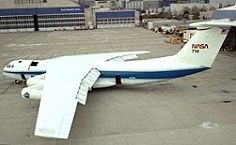



|
|
In addition to absorbing most of the infrared radiation from cosmic sources, the Earth's atmosphere itself radiates in the infrared which interferes with infrared observations. This is why it is best to get above as much of the atmosphere as possible to observe in the infrared. To do this, infrared detectors have been placed on balloons, rockets and airplanes, allowing astronomers to study longer infrared wavelengths. Even though these methods can only observe a small part of the sky for short periods of time, they have contributed much to infrared astronomy.
 The first cooled telescopes were those placed on rockets which could observe
the sky for several minutes before reentry. The first infrared all sky map
resulted from a series of rocket flights by the Air Force Cambridge
Research Laboratory. This project, called Hi Star, surveyed the cosmos
at wavelengths of 4, 10 and 20 microns. Although the total observation
time accumulated by these flights was only about 30 minutes, they
successfully detected 2363 reliable infrared sources which were published
in the AFCRL Infrared Sky Survey. About 70% of these sources matched
sources found by the Mount Wilson 2.2 micron survey.
Rockets also found bright infrared
emission from HII regions (regions of ionized hydrogen) and the center of
our galaxy.
The first cooled telescopes were those placed on rockets which could observe
the sky for several minutes before reentry. The first infrared all sky map
resulted from a series of rocket flights by the Air Force Cambridge
Research Laboratory. This project, called Hi Star, surveyed the cosmos
at wavelengths of 4, 10 and 20 microns. Although the total observation
time accumulated by these flights was only about 30 minutes, they
successfully detected 2363 reliable infrared sources which were published
in the AFCRL Infrared Sky Survey. About 70% of these sources matched
sources found by the Mount Wilson 2.2 micron survey.
Rockets also found bright infrared
emission from HII regions (regions of ionized hydrogen) and the center of
our galaxy.
Infrared telescopes onboard aircraft such as the Kuiper Airborne Observatory were used to discover the rings of Uranus in 1977. The KAO has been used to gather infrared astronomical data for over 20 years and can fly at an altitude of 41,000 feet which is above 99 percent of the Earth's water vapor. In addition to being able to study additional infrared wavelengths, airborne observatories can detect fainter infrared objects which cannot be observed well from the ground (such as interstellar clouds).

Plans are being made by NASA for a new airborne observatory. SOFIA - The Stratospheric Observatory For Infrared Astronomy will be an optical/infrared/sub-millimeter telescope mounted in a Boeing 747 and is expected to be fully operational by the year 2004.
|
|
HOME
INDEX